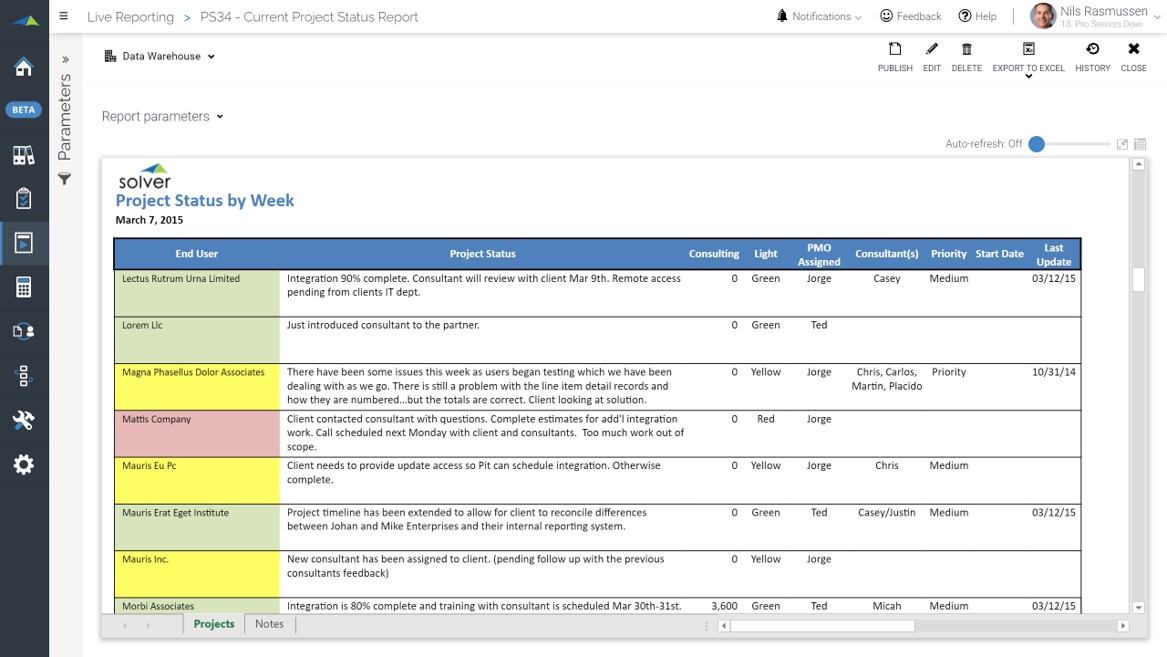Weekly Project Status Report for Professional Services Organizations
What is a
Weekly Project Status Report
? Weekly Project Status Reports are considered status tracking tools and are used by Project Managers (PMs) and Consulting Managers to display a quick status on each active project to give leaders internal dashboards and reports to show the overall health (e.g. green, yellow, red) across projects. Some of the main functionality in this type of report is that it can reduce or eliminate the need for other, manual project status tracking to give managers a quick health check on the company's active projects. The report displays the status as a color (seen as the background color in the first columns) along with key project data. Fields to display can include: Client, Project status, Consulting, Light (status), PMO assigned, Consultant, Priority, Start date, and Last update. You find an example of this type of report below.
Purpose of
Weekly Project Status Report
s Professional Services organizations use Weekly Project Status Reports to give service leaders a clear picture of the health of their delivery services. When used as part of good business practices in PMO and Consulting departments, a company can improve its ability to easily inform managers about project statuses across all clients to speed up tactical decisions, and it can reduce the chances that managers don't notice important issues as early as possible.
Example of a
Weekly Project Status Report Here is an example of a Weekly Project Status Report with color coding and comments.
 You can find hundreds of additional examples
here
Who Uses This Type of
Report
? The typical users of this type of report are: Service Leaders, Project Managers, Consultants.
Other Reports Often Used in Conjunction with
Weekly Project Status Report Progressive PMO and Consulting departments sometimes use several different Weekly Project Status Report, along with Consultant billing reports, billing revenue dashboards, project dashboards, detailed project and summary reports, revenue forecast models, annual budget models and other management and control tools.
Where Does the Data for Analysis Originate From? The Actual (historical transactions) data typically comes from enterprise resource planning (ERP) systems like: Microsoft Dynamics 365 (D365) Finance, Microsoft Dynamics 365 Business Central (D365 BC), Microsoft Dynamics AX, Microsoft Dynamics NAV, Microsoft Dynamics GP, Microsoft Dynamics SL, Sage Intacct, Sage 100, Sage 300, Sage 500, Sage X3, SAP Business One, SAP ByDesign, Acumatica, Netsuite and others. In analyses where budgets or forecasts are used, the planning data most often originates from in-house Excel spreadsheet models or from professional corporate performance management (CPM/EPM) solutions.
What Tools are Typically used for Reporting, Planning and Dashboards? Examples of business software used with the data and ERPs mentioned above are:
You can find hundreds of additional examples
here
Who Uses This Type of
Report
? The typical users of this type of report are: Service Leaders, Project Managers, Consultants.
Other Reports Often Used in Conjunction with
Weekly Project Status Report Progressive PMO and Consulting departments sometimes use several different Weekly Project Status Report, along with Consultant billing reports, billing revenue dashboards, project dashboards, detailed project and summary reports, revenue forecast models, annual budget models and other management and control tools.
Where Does the Data for Analysis Originate From? The Actual (historical transactions) data typically comes from enterprise resource planning (ERP) systems like: Microsoft Dynamics 365 (D365) Finance, Microsoft Dynamics 365 Business Central (D365 BC), Microsoft Dynamics AX, Microsoft Dynamics NAV, Microsoft Dynamics GP, Microsoft Dynamics SL, Sage Intacct, Sage 100, Sage 300, Sage 500, Sage X3, SAP Business One, SAP ByDesign, Acumatica, Netsuite and others. In analyses where budgets or forecasts are used, the planning data most often originates from in-house Excel spreadsheet models or from professional corporate performance management (CPM/EPM) solutions.
What Tools are Typically used for Reporting, Planning and Dashboards? Examples of business software used with the data and ERPs mentioned above are:
- Native ERP report writers and query tools
- Spreadsheets (for example Microsoft Excel)
- Corporate Performance Management (CPM) tools (for example Solver)
- Dashboards (for example Microsoft Power BI and Tableau)
Corporate Performance Management (CPM) Cloud Solutions and More Examples
July 19, 2021
TAGS:
Reporting,
Solver,
report writer,
Microsoft,
template,
practice,
Acumatica,
Netsuite,
Finance,
planning,
GP,
Business Central,
excel,
ax,
forecast,
Budget,
Professional Services,
Dynamics 365,
budgeting,
project status,
Cloud,
Software,
Tableau,
SAP,
example,
best,
Sage,
BC,
D365,
NAV,
Intacct,
services,
project,
CPM,
report,
SL,
Management,
dynamics,
Power BI,
status report,
project status report

 You can find hundreds of additional examples
You can find hundreds of additional examples